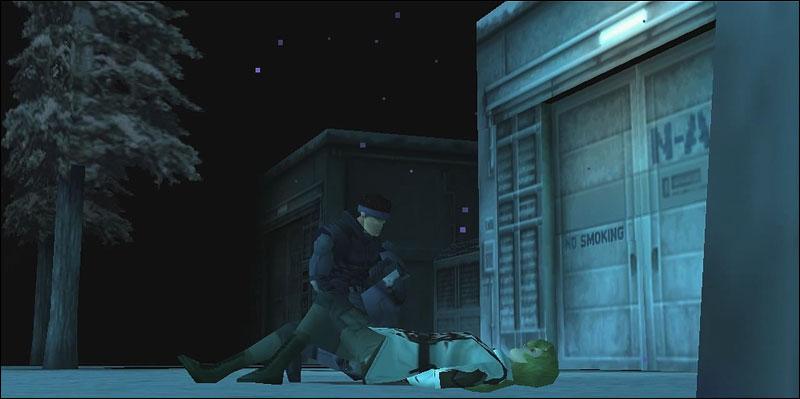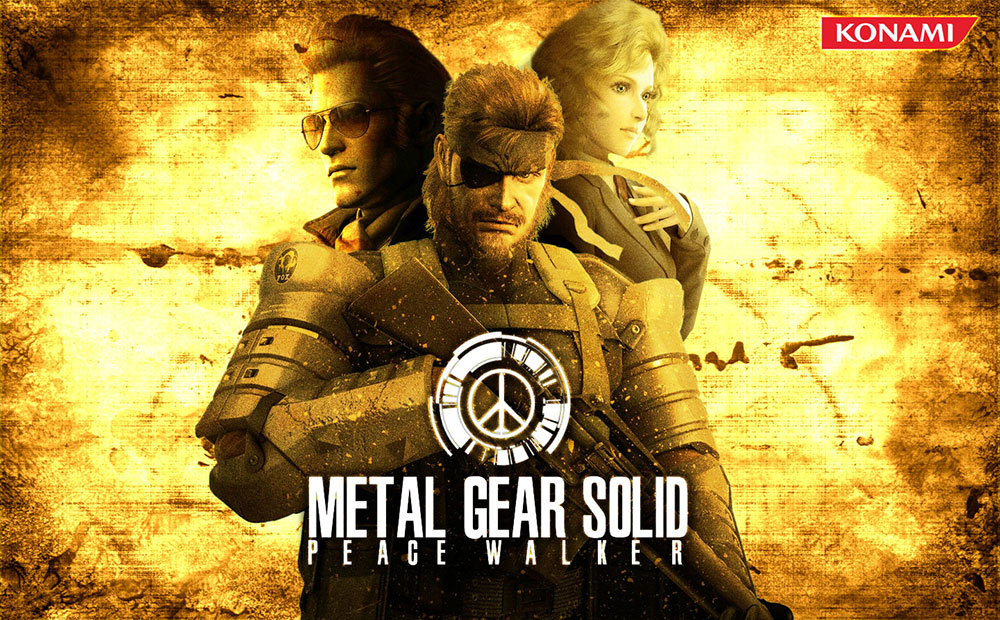Guest Post: Metal Gear Solid – A Retrospective PART 1
This retrospective has kindly been written by Shaun Sannerude, aka @rudecold
Metal Gear Solid V: The Phantom Pain – is Kojima’s final Metal Gear game his best yet? Part 1 – Memories
This two part retrospective opinion piece covers not only Metal Gear Solid V but the entire Metal Gear series, not including non-canon games such as Ghost Babel or the spin off game, Metal Gear Rising: Revengeance. There will be huge spoilers for all the games throughout both articles!
Metal Gear Solid is my all-time favourite game. It’s the game that I have completed and replayed the most and to an extent where I wore out the disc. I was 14 years old when it was released back in 1998 and like so many games on the PlayStation it was like nothing I had ever played before. It was literally a teenage boy’s wet dream. It had everything – an awesome lead character, a gigantic mecha with its own nuclear warhead called Metal Gear REX, an incredible set of bad ass villains; a deep and interesting storyline with a variety of twists and turns; a large arsenal of weapons, graphics that at the time were of the highest quality, beautifully crafted cinematic cut scenes and last but most certainly not least, you could break enemy’s necks!

(image by Digital Arts)
MGS was the first game that felt like a movie. It had such a high level of detail and quality throughout. The main theme I would hum for hours on end and the closing song – ‘The Best Is Yet To Come’ is a gorgeous, moving piece of music. The story was slick, engaging and ever so slightly nuts. The year is 2005 and you are Solid Snake, a retired agent of an elite special-forces unit called FOXHOUND. Solid Snake is brought out of retirement by his old Colonel on a mission to deal with a corrupt version of FOXHOUND under Liquid Snake’s leadership who has seized an isolated American nuclear weapons disposal facility. It had the amazing twist that Solid Snake and Liquid Snake are in fact twin brothers, artificially conceived from the legendary solider known as Big Boss. Solid Snake also carries a virus called Fox-Die implanted to wipe out FOXHOUND, which eventually kills off Liquid Snake. Like I said the story is pretty farfetched but also marvellous and mature.
The supporting cast of characters within the game all had intriguing stories of their own. On every play through I would always have a tear in my eye for Sniper Wolf (one of the members of the corrupt FOXHOUND unit). Wolf’s death scene is so powerful. After the battle with Snake, her blood-soaked body is found lying in the snow and she is barely alive. She hugs her rifle close to her body before asking Snake to be ‘set free’, while Otacon (a scientist that Snake rescues) professes his love for Wolf and begs Snake not go through with it. Otacon knowing that his pleads aren’t working turns his back to them both and covers his ears, the screen goes white followed by a gun shot and the howling of wolves. It still puts a lump in my throat just writing about it!

The game is full of epic scenes like the one above. Another favourite of mine is the corridor of massacred bodies caused by the character, Cyborg Ninja (a former ally / villain of Solid Snake previously known as Gray Fox and perceived to be dead by Solid Snake’s hands) who has gone on a brutal rampage. It’s shot straight like a scene out of a horror movie with blood coating the walls and ceiling and bodies strewed everywhere in a variety of different slumped positions. It made the scene so tense and fear provoking, knowing that at some point you would have to face the monster that caused this brutality.
Gameplay wise, it was one of the first to properly introduce stealth mechanics and have such varied and memorable boss battles, from having to gun down an attack helicopter to fighting Liquid Snake hand to hand on top of Metal Gear REX. There is also no boss quite like Pyscho Mantis (another member of the corrupt FOXHOUND unit). He knew your every move and I remember getting so frustrated fighting him, I just couldn’t win. This was the age before YouTube and having a decent internet access so looking up a video or a guide was completely out of the question. My friend eventually told me how to do it, I had to simply plug my controller into port 2 so that Mantis couldn’t read my moves. This blew my mind! Instantly, Hideo Kojima (the series creator) became a legend in my eyes. This and the fact that Mantis could read games off my memory card was the kind of creativity I had never experienced before in my early gaming years.

With my great love for MGS my anticipation for Metal Gear Solid 2: Sons of Liberty on its release for the PlayStation 2 was astronomical. I even bought Zone of Enders just to get my hands on the demo. I was also lucky enough to win a competition to go to the MGS2 press event in London and not only did I get to play the game to death, I also got to meet Harry Gregson Williams (the game’s music composer) and the main man himself – Kojima, wearing the most outrageous snake skin boots! It’s certainly a memory I will treasure forever!
MGS2 had visually one of the best openings to a game for its time. The PlayStation 2’s power enabled mouth-watering visuals with Snake boarding a tanker toing and froing on waves with the rain lashing down. absolutely lashing it down with rain. It was incredible and then my jaw hit the floor when the cut scene seamlessly transitioned into actual gameplay and the visuals were unaffected.

Gameplay was improved in the sequel with the ability to shoot in first person mode whilst also adding neat touches like being able to hang off ledges, hide bodies in lockers and hold enemies up at gun point. These little things drastically improved the feel of the game and set it apart from its predecessor.
Again, there was a good cast of characters and varied bosses but the story wasn’t as strong and became very confusing, thankfully it still kept the element of being stupidly nuts. For example, Liquid Snake returns by possessing Revolver Ocelot’s (member of the corrupt FOXHOUND unit in MGS who had his arm chopped off by Gray Fox) mind after Ocelot uses Liquid’s arm as a transplant to replace his lost arm and thus becoming Liquid Ocelot. Crazy right?! Of course the biggest talking point of the game, which a lot of people hated, was the introduction of Raiden, a rookie agent as the main playable character throughout most of the game. Personally, I had no problem with this as you got to see a different side to Solid Snake as he took on the pseudonym – Iroquois Pliskin and assisted Raiden in taking down the games antagonist Solidus Snake (who is revealed as the third clone of Big Boss and also Raiden’s adoptive father, having exploited him as a child solider).

Following MGS2 we got to go back in time in Metal Gear Solid 3: Snake Eater and learn the history of Solid Snake’s father, with the codename Naked Snake, a member of the CIA special forces unit called FOX before he became the legendary Big Boss. Set in the 60’s Cold War era the game largely takes place in a jungle setting rather than in urban environments. This gave the game a complete fresh feel with the introduction of a camouflage system and having to survive in the wilderness. A new hand to hand combat mechanism was also added which worked relatively well and played a large part in the final boss encounter against Naked Snake’s mentor – The Boss.
The Boss is still today one of the strongest female characters to ever appear in a game. Her story was incredible and concluded with another emotional heart wrenching ending when you learn that she isn’t the treacherous spy you are led to believe and is in fact under orders to pretend to defect so she could infiltrate the ranks and bring back secret military information for the United States of America. She sacrifices her honour and dies at the hands of Naked Snake who only learns of her role after he has killed her. The game ends with Naked Snake being awarded a medal and the title ‘Big Boss’ which he initially rejects and prompts him to retire from active service. The closing scene has Naked Snake visiting The Boss’s grave with a tear in his eye and a goodbye salute to her true patriotism.

MGS3 will largely be remembered for its strong storyline (which as a cool touch includes a young Revolver Ocelot who is Naked Snake’s rival) and an infuriating but brilliant sniper battle against the expert sniper – The End (member of the Cobra Unit – the game’s main antagonists). Kojima yet again shows his genius innovative skills by allowing you to bypass this fight by simply killing a defenceless The End shortly before the battle or if the player saves the game before the fight and waits a week (or adjusts the consoles system clock to a week ahead) The End will die of old age – how awesome is that?!
Big Boss’s story continues in handheld format with Portable Ops and Peace Walker both set in the 1970’s. It’s not 100% confirmed whether Portable Ops is canon but I can’t see why it wouldn’t be as the story fits nicely into the series. I won’t go into too much detail into these games but basically the story in Portable Ops follows Big Boss, still under his old codename: Naked Snake, having to go against the now rogue FOX unit, whilst in Peace Walker Snake creates his own mercenary unit, Militaires Sans Frontières (Soldiers Without Borders), to live out The Boss’s final will, to create a world where soldiers are free to choose their own fights, on their own terms, and not at the whim of a government. Both games are unfortunately let down by the handheld’s systems limitations with fiddly controls and dodgy camera but Peace Walker is noticeably more refined than its predecessor.

Solid Snake’s story is wrapped up with Metal Gear Sold 4: Guns of the Patriots. MGS4 is an exceptional and fitting end to the series. It’s pure fandom. It features all the beloved characters from throughout the series including the return of EVA (a triple agent from MGS3 who you learn in MGS4 is in fact Solid and Liquid’s mother); from MGS Meryl Silverburgh (who originally teamed up with Snake and was a kind of love interest), Mei Ling (was a data analyst who supported Snake with his mission) and Naomi Hunter (a geneticist and Gray Fox’s adopted sister) all return; and finally Raiden, now in kick ass cyborg ninja form, from MGS2. It wouldn’t be a perfect ending without bringing back Big Boss for the final scenes in the game to reconcile with his son before dying from the unintended exposure to the new Fox-Die virus.
Kojima was hugely brave in having Solid Snake return in MGS4 as an older man due to him suffering from accelerated aging because of his genetic code being designed to only having a short life span – he’s 42 years old in the game but looks to be in his 60’s. On the announcement of Old Snake, I admit I wasn’t too keen, but thankfully it worked out brilliantly as it was key to the plot with Old Snake only having about a year left to live therefore making this his final mission to kill Liquid once and for all. It also brought about the inclusion of a clever new gameplay system, the Psyche Meter. Depletion of this meter caused by stressors such as being hunted by the enemy and temperature extremes would make Snake suffer with aiming difficulties, back pain and the potential to pass out when receiving damage. This all helped add to the image of playing as an old man.

Throughout the Metal Gear series we have gone from self-contained urban environments to open jungles and MGS4 delivers a fresh environment with it being set in the middle of an urban warzone surrounded by Private Military Contracts waging war on one another. Even in this setting combat is still traditionally Metal Gear using close quarter combat and stealth which is aided significantly through the use of the OctoCamo suit. This gadget allows Snake to mimic the appearance and texture of any surface similar to an octopus or chameleon (hence its name). It’s a ridiculously cool concept that works brilliantly. You can’t help but marvel when Snake seamlessly blends with the environment with a guard practically on top of him unaware of his presence before Snake does what he does best and steps out of cover to snap his neck!
My one slight gripe with the game is with the Beauty and the Beast Unit which are the game’s antagonists led by Liquid Ocelot. The unit are four female soldiers suffering from post-dramatic stress order from the horrors of war who have been given special suits to turn them into incredible combatants. That’s literally all there is to their back stories, which is a definite missed opportunity. The boss battles are fairly interesting as they merge characteristics and abilities from past opponents across the games series but none of them are very memorable. Thankfully, my gripe doesn’t dampen my love for this game which follows MGS as my second favourite in the series.
With Part 1 complete the article will conclude with Part 2: My Phantom Pain which will follow shortly and I promise that Metal Gear Solid 5 will actually feature in it!

